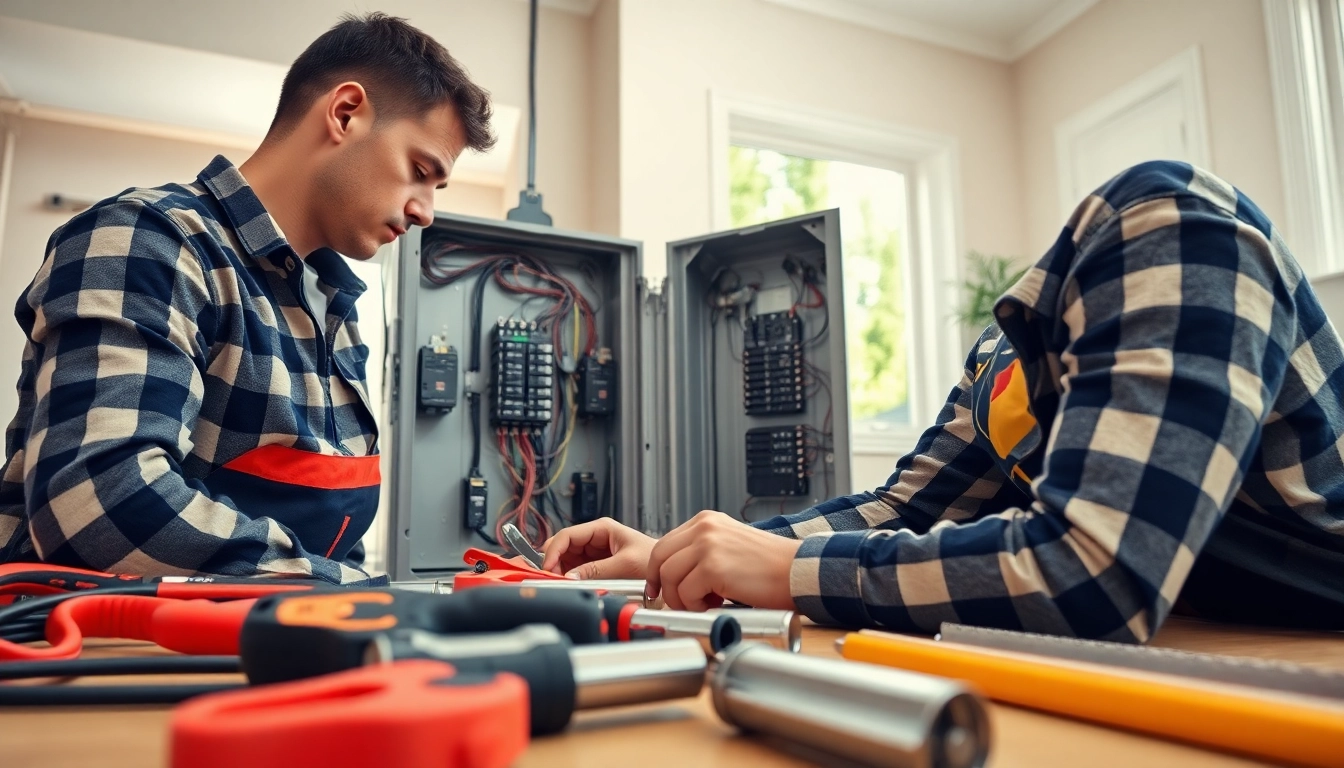
Understanding the Importance of an Electrical Panel Upgrade
Upgrading your electrical panel is a critical task that many homeowners overlook until they encounter significant problems. The electrical panel acts as the heart of your electrical system, regulating the power flow throughout your home. As our reliance on electrical appliances and devices increases, it becomes essential to ensure that our electrical panel can handle this demand. An electrical panel upgrade can enhance safety, increase capacity, and improve efficiency, making it a key consideration for homeowners.
Why Upgrading is Necessary for Your Home
The necessity for an upgrade often stems from several factors. First and foremost, if your home is older, it may still have a panel designed for much lower electrical loads than modern homes require. Many homes built before the 1980s typically have 100-amp panels, which may not suffice for contemporary electrical needs, especially with the advent of smart home technologies and electric vehicle (EV) chargers.
Additionally, upgrading your electrical panel can provide peace of mind regarding the safety of your home. Outdated panels can lead to frequent circuit overloads, which may cause fires or damage to your valuable electronics. An upgrade can ensure that your electrical system adheres to the latest safety standards, reducing the risk of electrical failures.
Signs That Indicate You Need an Upgrade
- Frequent Circuit Breaker Trips: If your circuit breakers trip frequently, it’s a sign that your electrical panel is struggling to handle your home’s electrical load.
- Flickering Lights: If the lights in your home flicker or dim when you turn on appliances, this may indicate that your electrical panel is undersized.
- Buzzing Noise: Any unusual buzzing sounds coming from the panel itself can be a sign of overheating wires or other significant issues.
- Old or Outdated Panel: Older panels, especially those made of aluminum, may not meet current safety standards and are more prone to failure.
- Need for More Outlets: If you’ve added many new electrical devices or plan to do so, you may need a larger panel to accommodate additional circuit breakers.
Safety Considerations for Electrical Panel Upgrades
Safety is paramount when it comes to electrical work. Upgrading an electrical panel involves high voltages and significant risks if not done properly. A professional electrician should always conduct electrical panel upgrades to ensure compliance with local codes and safety standards. Before proceeding with an upgrade, ensure that:
- The upgrade is done by a qualified and licensed electrician.
- The installation adheres to the National Electrical Code (NEC) and local regulations.
- All necessary permits are obtained prior to work commencement, as electrical work typically requires inspections for safety validation.
Choosing the Right Electrical Panel for Your Needs
Choosing the right electrical panel is a pivotal step in the upgrade process, impacting both functionality and safety in your home. There are various types of panels and considerations to keep in mind during the selection process.
Different Types of Electrical Panels
There are primarily two types of electrical panels used in residential settings:
- Conventional Circuit Breaker Panels: These are the most common, using circuit breakers to automatically shut off power during overloads, which helps prevent fire hazards.
- Smart Panels: Emerging technologies have led to the creation of smart panels that allow for advanced monitoring, real-time feedback on energy consumption, and integration with home automation systems.
Your choice largely depends on your specific needs and whether you want to future-proof your home with modern amenities.
Capacity and Size Requirements Explained
The capacity of your electrical panel is vital. Most homes today require a 200-amp service due to the increased load from modern appliances and electronics. When assessing your capacity needs, consider the following:
- Current Electrical Load: Calculate the total wattage of your home appliances, devices, and systems to determine your current usage.
- Future Needs: Consider potential future upgrades, such as adding electrical vehicles or additional home appliances.
- Local Codes: Check with local regulations regarding minimum service requirements for safety and compliance.
Assessing Brand Options for Electrical Panels
When selecting a brand for your electrical panel, consider reliability and the warranty offered. Some well-known brands in the market include:
- Square D: Known for its durable and high-quality panels.
- Siemens: Offers a range of reliable products with a strong reputation for safety.
- GE: Provides innovative products and is well-respected in the industry.
- Eaton: Has a good selection of panels that cater to both residential and commercial needs.
Choose a brand that aligns with your needs and preferences while ensuring that it meets safety standards.
Financial Aspects of an Electrical Panel Upgrade
Upgrading your electrical panel involves costs that vary based on several factors. Understanding these costs is crucial for budgeting appropriately and evaluating the long-term benefits of the upgrade.
Understanding the Costs Involved in Upgrading
The cost for an electrical panel upgrade can range significantly based on factors such as:
- Labor Costs: Electricians typically charge between $50 and $120 per hour, depending on location and expertise.
- Cost of the Panel: New panels range from $100 to $500 based on capacity and brand.
- Permit and Inspection Fees: Local building codes often require permits and inspections, which can add additional costs.
- Complexity of Installation: If additional wiring or modifications to the electrical system are needed, these costs can increase significantly.
On average, a panel upgrade can cost anywhere between $800 to $4,000, including all expenses.
Possible Financial Benefits and Savings
While the upfront costs can seem daunting, an electrical panel upgrade can lead to long-term savings:
- Increased Home Value: An updated electrical system can significantly increase your home’s marketability and value.
- Lower Insurance Premiums: Insurance companies often reduce premiums for homes with updated electrical systems due to lower risk profiles.
- Energy Efficiency: New panels can improve the efficiency of your electrical system, potentially lowering utility bills over time.
Exploring Tax Credits and Rebates
Homeowners may be eligible for tax credits and rebates when upgrading their electrical panels, especially if the upgrade improves energy efficiency. Programs vary by location and utility provider, but options may include:
- Federal Tax Credits: Certain energy-efficient upgrades may qualify for federal tax credits, reducing your tax burden.
- State and Local Incentives: Many states offer rebates or incentives for energy-efficient home improvements that can offset the costs of an upgrade.
- Utility Provider Rebates: Some utility companies provide rebates for customers who upgrade their electrical systems and appliances to energy-efficient models.
Research the opportunities available in your area to maximize financial benefits during your electrical panel upgrade.
Hiring a Professional for Your Electrical Panel Upgrade
Choosing the right professional to conduct your electrical panel upgrade is crucial for ensuring safety and compliance. Quality workmanship can prevent future problems and provide peace of mind.
Finding Qualified Electricians
To find qualified electricians, consider the following:
- Licensing and Certification: Always check that the electrician is licensed and certified to perform electrical work in your area.
- Experience and Specialization: Seek out electricians with experience in panel upgrades and who can provide references or testimonials from previous clients.
- Seek Recommendations: Ask friends, family, and neighbors for referrals to reputable electricians.
Evaluating Cost Estimates and Proposals
Once you’ve narrowed down some potential electricians, it’s time to request estimates. Here’s how to evaluate them effectively:
- Get Multiple Quotes: Obtain at least three estimates to compare pricing and services.
- Scope of Work: Ensure that each estimate covers the same scope of work to accurately compare them.
- Detailed Breakdown: Look for detailed breakdowns of costs, including labor, materials, and any permits.
Questions to Ask Your Electrician Pre-Upgrade
Before proceeding with an upgrade, it’s essential to communicate effectively with your chosen electrician. Consider asking the following questions:
- What is your experience with electrical panel upgrades?
- Are you licensed and insured?
- What kind of panel do you recommend for my specific needs?
- Can you provide references or testimonials from past clients?
- What warranties or guarantees do you offer on your work?
Maintenance Tips After Your Electrical Panel Upgrade
Once your electrical panel upgrade is completed, maintaining it properly is vital for ensuring long-term efficiency and safety. Here are essential tips for post-upgrade maintenance:
Routine Maintenance for Longevity
To prolong the life of your upgraded electrical panel, perform regular maintenance, including:
- Visual Inspections: Regularly check for signs of corrosion, rust, or any unusual wear.
- Clean the Panel: Dust and debris can build up; keeping the panel clean ensures optimal function.
- Test Circuit Breakers: Regularly test and reset circuit breakers to ensure they function properly.
Common Issues to Look Out For
Be vigilant for common problems that may arise after an upgrade, such as:
- Frequent Tripping of Breakers: If breakers continue to trip, it may indicate issues with wiring or overload.
- Moisture or Burns: Signs of moisture or burn marks around the panel are severe and require immediate professional assessment.
- Overheating: If the panel feels hot to the touch, this indicates a possible electrical fault.
When to Call a Professional Post-Upgrade
If any concerning signs appear after your panel upgrade, do not hesitate to contact a professional electrician. Signs that require expert help include:
- Persistent breaker tripping despite minimal load.
- Unusual sounds, smells, or persistent overheating.
- Consistent flickering lights, indicating wiring problems.
Proactive maintenance and addressing issues promptly will help ensure that your upgraded electrical panel continues to operate safely and efficiently for years to come.





